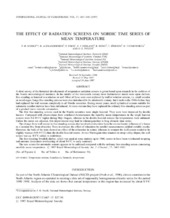| dc.contributor.author | Nordli, Øyvind | eng |
| dc.contributor.author | Alexandersson, H. | eng |
| dc.contributor.author | Frich, P. | eng |
| dc.contributor.author | Førland, E. J. | eng |
| dc.contributor.author | Heino, R. | eng |
| dc.contributor.author | Jónsson, T. | eng |
| dc.contributor.author | Tuomenvirta, H. | eng |
| dc.contributor.author | Tveito, O. E. | eng |
| dc.date.accessioned | 2009-09-17T14:16:48Z | |
| dc.date.available | 2009-09-17T14:16:48Z | |
| dc.date.issued | 1997-12 | eng |
| dc.identifier.issn | 1097-0088 | en_US |
| dc.identifier.issn | 0899-8418 | en_US |
| dc.identifier.uri | https://hdl.handle.net/1956/3473 | |
| dc.description.abstract | A short survey of the historical development of temperature radiation screens is given based upon research in the archives of the Nordic meteorological institutes. In the middle of the nineteenth century most thermometer stands were open shelters, free-standing or fastened to a window or wall. Most of these were soon replaced by wall or window screens, i.e. small wooden or metal cages. Large free-standing screens were also introduced in the nineteenth century, but it took to the 1980s before they had replaced the wall screens completely in all Nordic countries. During recent years, small cylindrical screens suitable for automatic weather stations have been introduced. At some stations they have replaced the ordinary free-standing screen as part of a gradual move towards automation. The first free-standing screens used in the Nordic countries were single louvred. They were later improved by double louvres. Compared with observations from ventilated thermometers the monthly mean temperatures in the single louvred screens were 0.2-0.4°C higher during May-August, whereas in the double louvred screens the temperatures were unbiased. Unless the series are adjusted, this improvement may lead to inhomogeneities in long climatic time series. The change from wall screen to free-standing screen also involved a relocation from the microclimatic influence of a house to a location free from obstacles. Tests to evaluate the effect of relocation by parallel measurements yielded variable results. However, the bulk of the tests showed no effect of the relocation in winter, whereas in summer the wall screen tended to be slightly warmer (0.0-0.3°C) than the double louvred screen. At two Norwegian sites situated on steep valley slopes, the wall screen was ca. 0.5°C colder in midwinter. The free-standing Swedish shelter, which was used at some stations up to 1960, seems to have been overheated in spring and summer (maximum overheating of about 0.4°C in early summer). The new screen for automatic sensors appears to be unbiased compared with the ordinary free-standing screen concerning monthly mean temperature. | en_US |
| dc.language.iso | eng | eng |
| dc.publisher | Royal Meteorological Society | en_US |
| dc.subject | Temperature screens | eng |
| dc.title | The effect of radiation screens on Nordic time series of mean temperature | en_US |
| dc.type | Peer reviewed | |
| dc.type | Journal article | |
| dc.description.version | publishedVersion | en_US |
| dc.rights.holder | Copyright 1997 Royal Meteorological Society | en_US |
| dc.identifier.doi | https://doi.org/10.1002/(SICI)1097-0088(199712)17:15%3C1667::AID-JOC221%3E3.0.CO;2-D | |
| dc.source.journal | International Journal of Climatology | |
| dc.source.40 | 17 | |
| dc.source.14 | 15 | |
| dc.source.pagenumber | 1667-1681 | |
| dc.subject.nsi | VDP::Matematikk og Naturvitenskap: 400::Geofag: 450::Meteorologi: 453 | nob |
